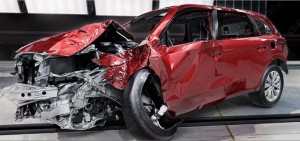There was a time when an automaker might have to build dozens of costly prototypes just to crash them in an effort to meet federal safety standards. These days, most of the work is done by computer simulation. But the challenge is to ensure that what goes on in the virtual world accurately reflects what would happen not only in a physical crash test but in the real world.
Honda has turned to a new 3D software system that promises to make crash simulations more realistic while saving both time and money in the process of developing new vehicles.
“With this technology, we have gained the potential to improve the quality of decision making and reduce the time required for finalizing a vehicle design by greatly increasing the ease of communicating and understanding the results of a crash test simulation,” explained Eric DeHoff, the technical leader for computer aided engineering, in the Crash Safety Group of Honda R&D Americas, Inc.
Dubbed DELTAGEN, the software was developed in Detroit, noted DeHoff, who said it offers both engineers responsible for designing vehicles and more senior executives a better look at the impact of crashes on a vehicle’s structure and its occupants.
In years past, it could take months to build a physical prototype, crash it, study the data and then begin all over, hoping to improve the results. Today, a number of virtual crashes can be run in a single day, tweaking designs each time to make the vehicle safer. The challenge is to interpret the traditional, two-dimensional images that are produced by those simulations.
(Automakers on track to break all-time recall record by mid-year. Click Herefor the story.)
The new DELTAGEN technology takes the output from a commonly-used crash simulation software package, known as LS DYNA CAE, and renders the event in a more life-like three dimensions. The visualization technology, which was first designed for use in the animation and film industry, enables Honda engineers to more easily study the results of a crash simulation, test different design approaches and implement design changes with greater speed and efficiency.
Honda engineers can manipulate the rendering produced by the software, rotate the view in any direction and strip away parts of the vehicle to isolate a section or component for more thorough analysis.
The crash barrier can also be rendered transparent in the virtual environment so the immediate effects of a crash can be viewed from multiple points of view, including the driver’s seat.
(Are you driving a car with deadly, unseen defects? Click Here to find out.)
The visualization software was co-developed by Honda R&D Americas Inc., the North American research and development arm of Honda, and 3DXCITE, which was formerly known as RTT before its German owners sold it to Dassault Systems, the big French maker of engineering software.
DeHoff said he was impressed with RTT’s capabilities after seeing a rendering of a Honda prototype produced by one of his computer technicians on his own time. After some preliminary discussion, he asked RTT to integrate its unique software with Honda’s existing crash simulation data collection system to deliver a detailed 3D rendering of accident simulations. Honda engineers provided detailed parameters of the tool and oversaw its development, DeHoff explained.
“This technology would not have become a reality without the vision and leadership of Honda engineers,” said Tom Celusnak, Solutions Architect for 3DXCITE, who noted that the software is capable of producing highly realistic images.
(Airbag problems force Honda, Nissan, Mazda to recall nearly 3 million vehicles. Click Here for the latest.)
While there have been efforts to create 3D crash simulations in the past, they were extremely limited in their capabilities, requiring a “concentrated effort” that still might take weeks to produce, noted Honda’s DeHoff.
“With this new technology we can create and manipulate the simulation at the push of a button, and we can do it in hours instead of weeks,” he added.
RTT originally developed the software to work with creators of video games and movies. It opened a one-man office in Troy, Michigan, a decade ago to see if automakers would be interested in using the technology for advertising. Today, the operation now known as 3DXCITE has 150 employees in the Detroit suburbs and has helped several automakers create animated advertisements and video-game-like displays for dealerships and auto shows.
Honda shows the software’s potential in an entirely new arena. The maker has been utilizing so-called non-linear crash simulation technology since 1998 as part of its new-model development process. That process has paid off, Honda and its Acura luxury division winning more Top Safety Pick ratings from the Insurance Institute for Highway Safety than any other automaker, DeHoff noted.


This would be quite useful if the input and output data are accurate.